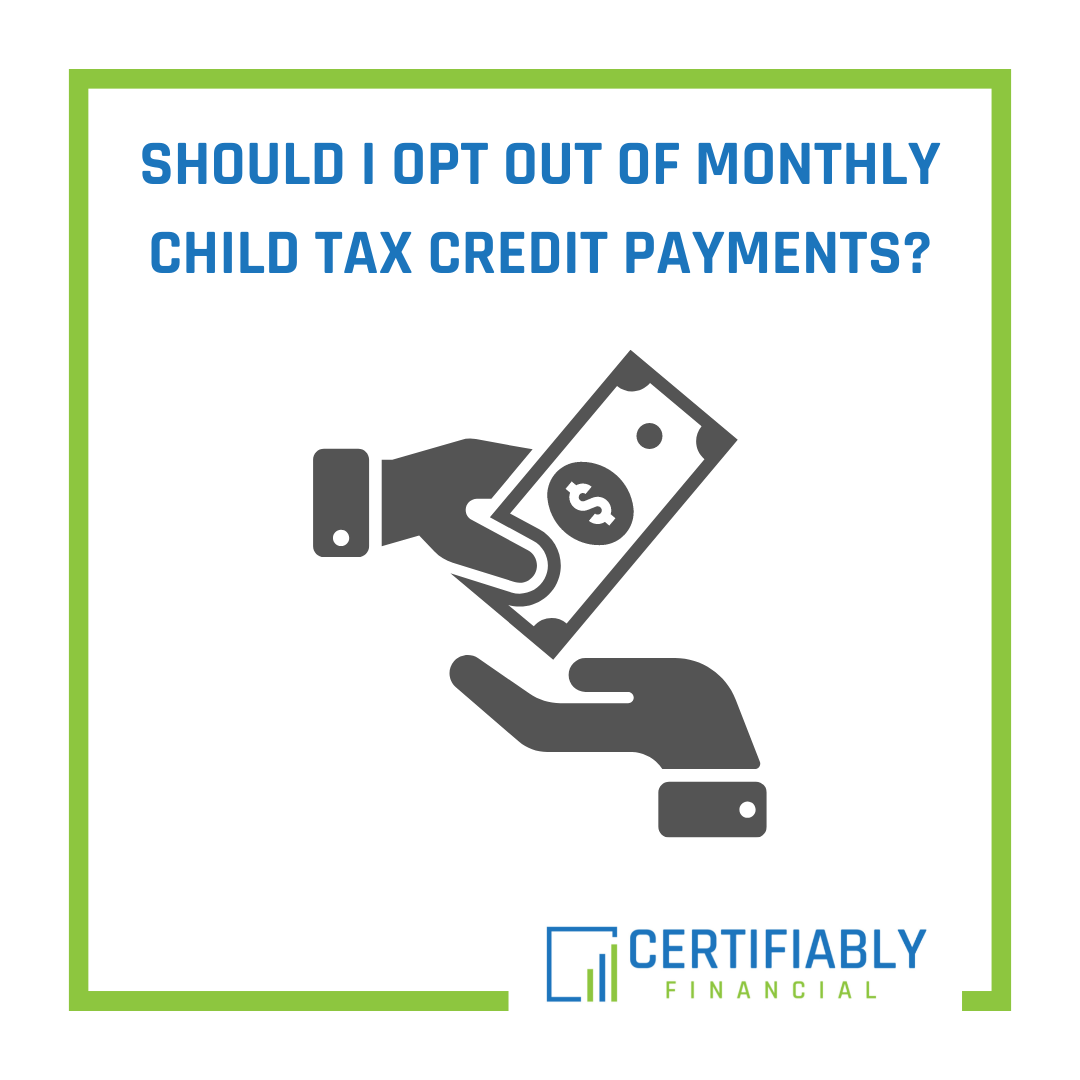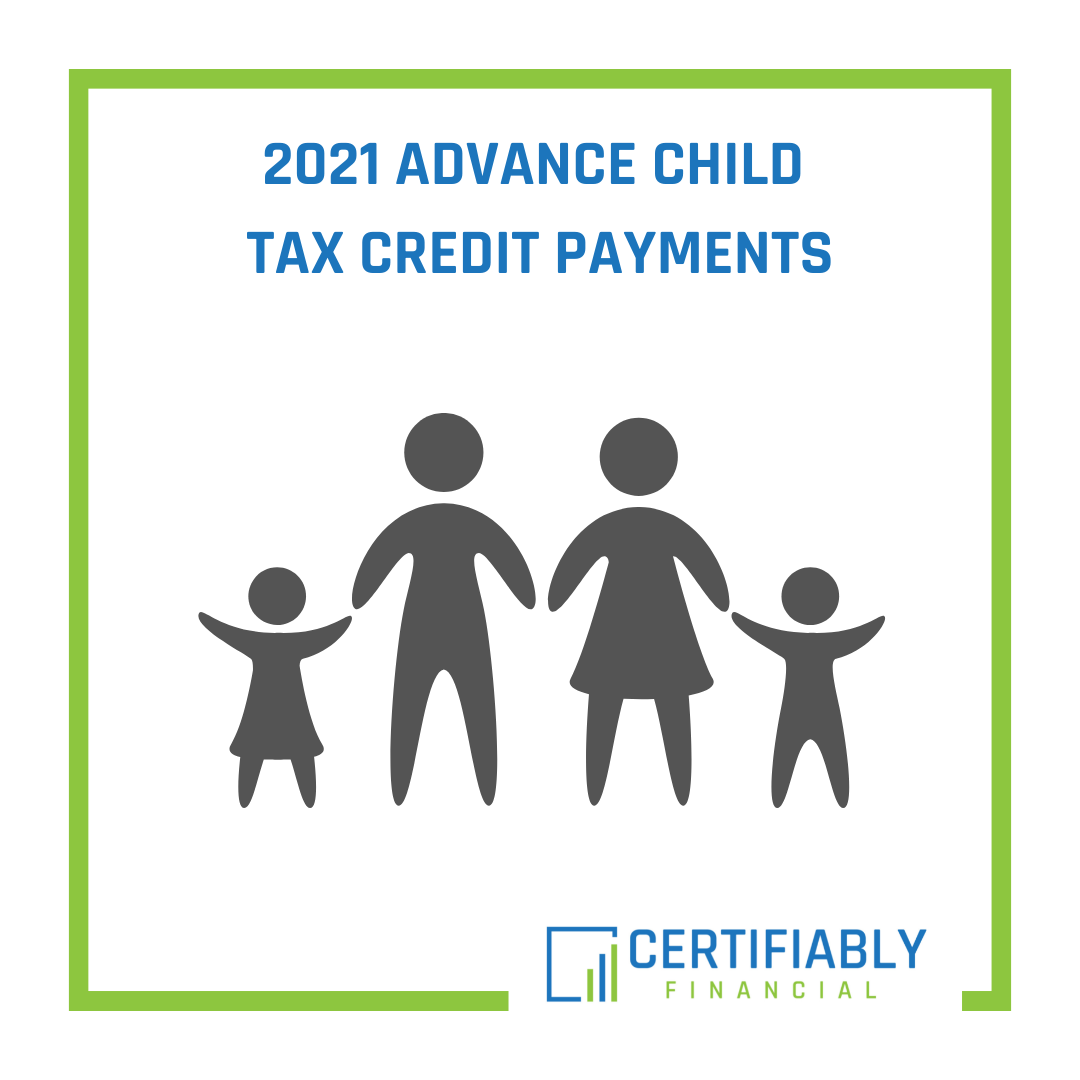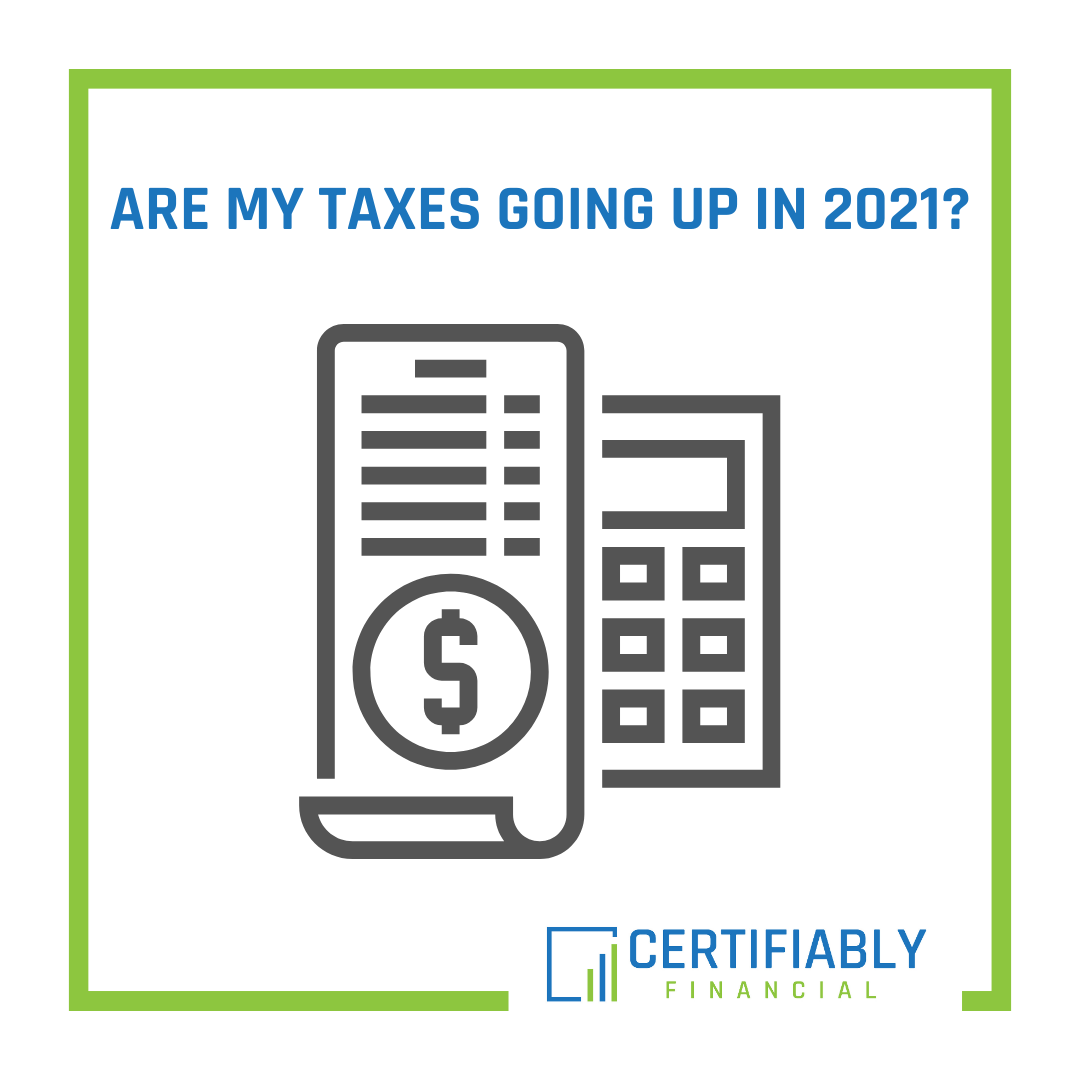As I wrote last week, you may be set to receive Advance Child Tax Credit payments if you received a Child Tax Credit on the last tax return that you filed and your income qualifies you for the payments. You should have received a letter from the IRS about this if you qualify. Essentially, (again, if you qualify) the IRS will be sending half of your estimated 2021 Child Tax Credit as advance payments from July through December. If you want to learn more about Advance Child Tax Credit payments, you can find the article here.
Taxes
2021 Advance Child Tax Credit Payments
Kids are expensive. According to the USDA, the cost of a middle-income married couple raising a child born in 2015 was expected to be $233,610 from birth through the child’s age 171. That seems like an insane amount of money. Luckily, a law passed earlier this year may help out with a small portion of your 2021 expenses.
Are My Taxes Going Up in 2021?
I’ve heard many versions of the question “Aren’t taxes going up?” over the past couple of weeks. This often comes along with a misguided (but partially true) statement about something that the person has heard about President Biden’s proposed tax plan. Unfortunately, we’re often provided with the headlines that make compelling news rather than a detailed report of the news.
Day 23 Of 30 Days Of Stay-At-Home Personal Finance Wins: Review & Update Your W-4
What if you were able to come out of this time of social distancing and economic crisis with a stronger and healthier financial life? What if you looked at this as an opportunity to take a little bit of your extra time each day to work on your finances?
Day 4 Of 30 Days Of Stay-At-Home Personal Finance Wins: File Your Tax Return (Maybe)
What if you were able to come out of this time of social distancing and economic crisis with a stronger and healthier financial life? What if you looked at this as an opportunity to take a little bit of your extra time each day to work on your finances?
Tips To Lower Your 2019 Taxable Income
3 minute read
Save To Tax-Advantaged Accounts
There are many options for you when it comes to saving that will help you to decrease your taxable income. Contributing money to an employer provided retirement account such as a 401(k) or 403(b), saving to an IRA, or contributing to a Health Savings Account (HSA) are all ways to decrease your taxable income, which in turn will decrease the amount of taxes that you’ll have to pay. An even bigger benefit to saving to these accounts is that you’ll be helping your future self prepare for retirement and/or large medical expenses.
Another option is to save to a 529 College Savings Plan. Indiana residents who file taxes in Indiana receive a 20% tax credit on up to $5,000 in contributions to Indiana CollegeChoice 529 Savings Plans. That’s up to a credit of $1,000 taken directly off your tax bill ($5,000 contribution x 20% credit). Tax credits are better than tax deductions because they reduce your tax bill dollar-for-dollar whereas deductions only marginally reduce the amount of taxes that you pay.
Maximize Your Employee Benefits
Besides making contributions to your employer retirement account, there are often other employee benefits that employers provide that you can take advantage of to reduce your taxable income. Some of the best, but often overlooked, benefits that you may have available to you are the dependent care FSA and the HSA, which I mentioned above.
An HSA will not only allow you to save on Federal taxes, but you also do not pay FICA (Social Security & Medicare) taxes on money that you contribute to the account, if the contributions are setup through your employer’s payroll system. (if you make contributions directly, then you’ll still have to pay FICA taxes on that money).
If you’re paying for daycare or before/after school care for your kids, then contributing to a dependent care FSA is a no-brainer. You’re already paying for the care for your child and using the dependent care FSA allows you to do so in a tax-free manner, up to a limit. You should be taking advantage of this benefit if it’s available to you and you’re currently paying for dependent care expenses.
File A New W-4
A W-4 is a the Employee’s Withholding Allowance Certificate that you file with your employer (you probably did this when you first began working there). This document tells your employer (or more likely your employer’s payroll company) how much to withhold from your paycheck for taxes.
If you owed a significant amount in taxes this year, or even if you’re getting a hefty refund, you may want to consider filing a new W-4 with your employer to have a more appropriate amount withheld from your paycheck. This can help to make sure that you don’t end up in the same situation come tax time next year. While updating your withholdings through filing a new W-4 doesn’t decrease your taxes, it can help to make things easier when it comes time to file next year – making sure that there’s not a large balance due when you file or making sure that you keep more money in your pocket throughout the year and receive a smaller refund.
Start Saving On Taxes Now
Articles about how to save money on taxes are usually written towards the end of the year when people begin to think about how much they will owe and start trying to figure out if there are any last minute things they can do to decrease their taxes. Being proactive and starting to implement some of these strategies now will help you make sure that you’re able to relax while everyone else is searching for end-of-year tax savings tips.
What Are You Going To Do With Your Bonus And/Or Tax Refund?
3 minute read
Invest
Look, I’m a financial planner. My immediate thought is to pay yourself first and increase your savings and/or investments. If you’re not saving and investing a significant portion of your income already, then this can be a great way to get started. By now we all know how important investing for our future is, but most young professionals don’t take it as seriously as they should. Any extra money that you get from a bonus or tax refund could be a great opportunity to do something that your future self will thank you for.
Pay Down Debt
On the other hand, if you have high interest rate debt, then applying your extra cash to pay that down may be more beneficial. Using your money optimally is just a math game that depends on the interest rate on your debt and your expected rate of return of your investments. However, not everyone is motivated by getting the best rate of return possible for their money.
Some people really hate debt and would rather pay it down as quickly as possible, no matter whether it’s the most mathematically optimal decision or not. That’s a fine option as well, but we need to make sure that it makes sense within our overall financial plan.
Spend
I’m not telling you that you shouldn’t spend any of your tax refund or bonus. Everyone needs to be able to spend on things and experiences that they want and that make them happy, but you shouldn’t let doing so get in the way of reaching your financial goals.
This is why it’s so important to have your goals for what you want your money to accomplish for you explicitly stated. Otherwise, you’re likely to waste a lot of money (and a lot of progress towards your true goals) by spending on things that don’t really make you happy or provide you with much value because you’re trying to keep up with the Joneses.
Save For A Short-Term Goal
If you don’t have high interest rate debt and you save an adequate amount, then why not get started on saving for your summer vacation or plan a trip if you don’t have one already planned? I’m always going to value spending on travel and other experiences much more highly than spending on “stuff”, but if stuff is what makes you happy, and you’re in a good spot, then go ahead and buy that thing that you’ve really been wanting – within reason of course.
My Goal
My goal is to save/invest 50% of my bonus and tax refund, at least. Not only will this help me get a jump start on my annual savings goals, but it will also help to reduce lifestyle creep which can become a problem if spending increases over time without savings increasing as well.
The beginning of the year has seemed even busier for Amanda and me than the end of 2018 did, which has led to a little bit more spending than I would have liked. However, most of that spending has been on experiences that I’ve enjoyed, rather than things that I’d probably not care about in a couple of months, so I can’t be too upset. We still have a couple more weekends left that are booked, but I’m confident that I’ll be able to save at least half of my bonus and tax refund not only for long-term investing, but also for short-term goals such as our wedding and travel.
An Anytime Tax Saving Strategy For Indiana
3 minute read
The funny thing is that people could have been taking advantage of almost everyone of those tips throughout the year rather than waiting until December and having a deadline push them to make sure that they get it done. There isn’t really anything special about the end of the year when it comes to saving money on taxes except it gives you a deadline to complete most of these things by and it’s the time when most people are thinking about making charitable contributions that could reduce their taxes.
Luckily, those of us who live in Indiana have a “year-end” tax planning strategy that provides benefits beyond just tax savings for this year. Actually, that’s a lie. You can complete this strategy at any point throughout the year and still receive the benefits – it’s an “anytime” tax saving strategy.
Might as well join the crowd, right? But, I only have one tip for you, not a full list. And it (mostly) only applies to those who file taxes in Indiana.
Enter The 529 Savings Plan
The 529 Savings Plan was originally created in 1996 as a tax-advantaged post-secondary education savings plan for college, technical school, and vocational school, but has recently been changed to allow the money to be used for primary and secondary education tuition as well (up to $10,000 per student per year).
The tax advantages of a 529 plan come from investing the money and using it for education expenses. You can contribute money to a 529 Plan, choose an investment option and allow the money to grow tax-deferred, and then pull out the money tax free, if you use it for qualified education expenses. Withdrawing money from the account to use it for anything besides qualified education expenses will result in having to pay taxes on the earnings portion of the account as well as paying a 10% penalty.
The Indiana 529 Plan Advantage
In addition to being able to save in a tax-advantaged account for a loved one’s education, Indiana offers a tax credit for contributing to a 529. As of 2018, you can receive a 20% tax credit on up to a $5,000 contribution to an Indiana 529 Savings Plan if you are a resident of and file your state taxes in Indiana.
For example, if you contribute $5,000 to an Indiana 529 Savings Plan and are an Indiana filer, then you will receive a $1,000 credit on your Indiana income tax ($5,000 x 20%). This is the maximum credit available. If you contributed $1,000 to the plan, then you’d receive a $200 tax credit.
A tax credit is better than a tax deduction (you receive deductions for things such as charitable contributions and saving to your retirement account) because a credit reduces your tax bill dollar-for-dollar while deductions only marginally reduce your tax bill.
That’s an awesome benefit for helping someone receive further education and helping to reduce the burden of paying for it.
If you’re looking for a last minute tax strategy, just want to save some money on qualified education expenses that you’re already paying for anyways (why wouldn’t you), or even need a holiday gift idea (although it may not be appreciated until much later), then you might want to consider contributing to a 529. However, you need to be certain that your contributions to the account are initiated via electronic funds transfer by December 31 to be eligible. Otherwise, you’ll lose out on your 2018 tax credit and will have to settle for a credit in 2019 and beyond.
When you’re done making sure that you help fund someone’s education and receive a tax benefit for doing so in 2018, you might as well set up automatic contributions for 2019 so that you don’t have to rush through this same process again next December. Remember, this is an anytime tax saving strategy, not a year-end tax saving strategy.
If you’re an Indiana tax filer and you pay for qualified education expenses at a qualified primary school, college, technical school, or vocational school and you’re not contributing to an Indiana 529 plan, then you’re missing out on a tax credit that you should be taking advantage of. Even if you have a child who is a senior in college and you plan on paying for their final semester in the spring, you could still benefit by contributing to a 529 plan and receiving the tax credit in 2018. Don’t be the person who misses out on tax savings because you waited until the last minute to do something that could have been done at anytime throughout the year.
The Potential Hidden Cost of Student Loan Forgiveness
2 minute read
PSLF is available to those who work in government or not-for-profit and make 120 consecutive qualifying monthly payments towards their student loans. There are a lot of details around this, but those are for another day. Check the PSLF link above if you’re interested in learning more. To be eligible, an individual must complete the PSLF Employment Certification Form for each year that they worked for an eligible employer and made eligible payments. If all of the requirement are satisfied, then any remaining federal student loan balances will be forgiven.
Income-driven repayment plans tie your student loan payments to your income. If you fulfill all of the requirements, including recertifying annually, then any remaining federal student loan amount at the end of 20-25 years (depending on payment plan) will be discharged.
Keep in mind that these programs are for Federal student loans. You’ll likely end up being responsible for paying all of your private student loans yourself, even if you work for the government or a nonprofit.
Currently, any loans that are forgiven under PSLF are not treated as taxable income. However, loans discharged under the income-driven repayment plan options after 20-25 years of payment are treated as taxable income in the year that they’re forgiven. This is something to be aware of since laws always change and there has been some discussion about this topic recently.
For example, if someone had $100,000 of student loans forgiven under PSLF, then they would not have to pay any taxes on that amount. However, if someone were in the 24% tax bracket and had $100,000 of student loans discharged under a repayment plan, then they could have an extra $24,000 of taxes to pay in that year.
Before using these programs, you should run the numbers to see if it’s worth utilizing them. You could actually end up paying more in payments and taxes than if you were to just pay the loans off more quickly.
To Roth or Not to Roth
3 minute read
Roth vs Traditional
In a traditional 401(k), you contribute money pre-tax, allow the money to grow tax-deferred, and pay the taxes later when you withdraw the money. With a Roth 401(k), you pay the taxes today, allow the money to grow tax-free, and withdraw the money tax-free in retirement (assuming that you meet the Roth withdrawal rules). For someone in their 20s or 30s who plans to retire in their 60s, that could mean 30-40 years’ worth of tax-free growth and subsequent withdrawals in retirement. If the government doesn’t change the laws, the money that you contribute to Roth accounts today will never be taxed again.
What’s the worst that can happen? You pay taxes on your Roth contributions today at your current tax rate and then you pay taxes on your investment earnings when you withdraw the money in the future at your tax rate at that time? That’s likely not going to be much different than making pre-tax contributions today which will be 100% taxable when you withdraw them in the future. A couple with $1 million in a Traditional pre-tax IRA really has closer to $780,000 available to them, if they’re in the 22% tax bracket during retirement.
Consideration of Tax Brackets
If you think that your tax bracket will be lower in the future than it is today, then making pre-tax contributions might be a better option. You’d rather not pay the taxes while in a higher tax bracket today and be able to defer paying them until you’re in a lower tax bracket in retirement.
Conversely, if you think that you’re in a lower tax bracket today than you will be in retirement, then making Roth contributions may be a better option for you. You’d rather pay the lower taxes today than have to pay taxes later in your working career when you’re earning more money or when you’re in a higher tax bracket in retirement.
Personally, my goal is to be in a higher tax bracket later in life than I am today. If all goes as planned, the taxes that I’m paying now are probably going to be lower than those that I’ll have to pay 20 years from now or in retirement. As you continue to make more money in your career you can always switch from Roth contributions to pre-tax contributions to help save money on taxes, if you need to.
Another thing to consider is if you think that tax rates will increase or decrease in the future. If you think they’ll increase in the future, which would put you in a higher tax bracket than today, then Roth would be a better option. If you think that they’ll go down in the future, then pre-tax would probably be a better option.
Combine Both Strategies
Another option is to make 50% of your contributions pre-tax and 50% of them Roth. This allows you to have some tax diversification in retirement which could come in handy. This option would allow you some tax deductions today as well as tax-free withdrawals in the future.
Advantages of Roth 401(k)
The advantages of a Roth 401(k) over a Roth IRA are
1. There isn’t an income limit to make contributions to a Roth 401(k).
2. You can contribute much more to a Roth 401(k) in a year than you can to a Roth IRA.
In 2018, if you earn $135,0000 as a single filer or $199,000 as a married couple filing jointly, then you cannot contribute to a Roth IRA (phaseouts begin at $120,000 for single filers and $189,000 for those who are married filing jointly). On the other hand, there is no income limit to contribute to a Roth 401(k).
The maximum amount of money that you can contribute to a Roth 401(k) in a year is $18,500 for people younger than 50 years old and $24,500 for those age 50 and older. Please keep in mind that any Roth contributions as well as any pre-tax contributions that you make to your 401(k) count towards these amounts of $18,500 and $24,500. Contributions to a Roth IRA are limited to $5,500 for those younger than 50 and are $6,500 for those age 50 and older. As with a 401(k), you are only allowed to make an aggregate contribution of $5,500 ($6,500 for those over 50) to your IRAs.
Contributing to Roth accounts can provide you with great planning strategies and flexibility in retirement. This is a strategy that most young people should seriously look into and consider implementing as a part of their overall financial plan. However, as with almost everything in finance, it depends on your personal situation.










